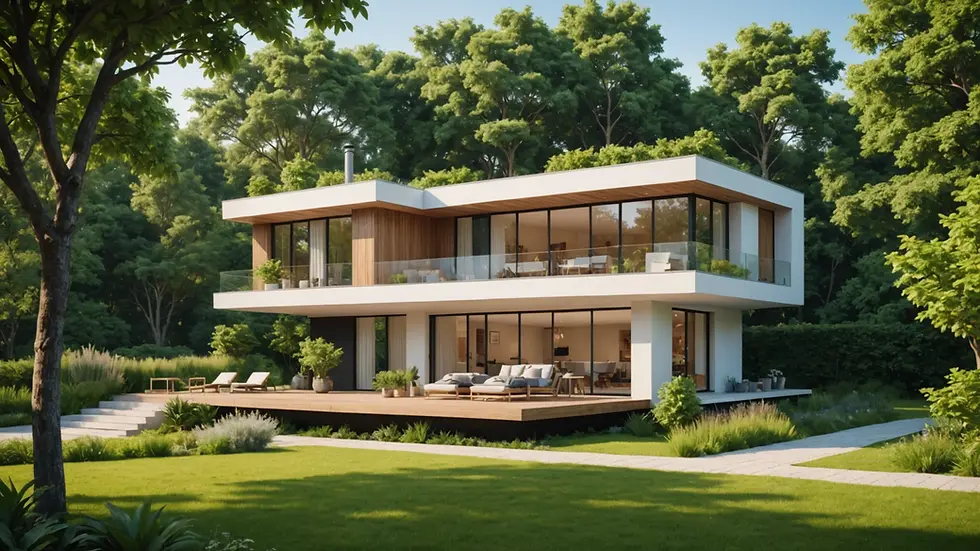Sustainable design trends in 2025: what's in hot in the eco-friendly homes
- Erin Carvalho
- Dec 10, 2024
- 4 min read
In recent years, sustainable living has grown from a niche interest into a significant lifestyle choice. As we move into 2025, the design community is making bold advancements in creating eco-friendly homes that are both beautiful and environmentally responsible. This blog post will explore the latest sustainable design trends, spotlighting innovative materials, energy-efficient technologies, and creative ideas that will inspire your journey toward a greener lifestyle.
Innovative Eco-Friendly Materials
With the rising demand for sustainable designs, architects and builders are increasingly utilizing materials that reduce environmental impact. Here are some standout eco-friendly materials gaining traction in 2025:
Bamboo
Bamboo is celebrated for its fast growth and renewability. In modern homes, bamboo is not just limited to flooring; it also serves as a key material in furniture, cabinetry, and structural supports. For instance, bamboo flooring can be up to 60% more sustainable compared to traditional hardwoods due to its ability to mature in just 3 to 5 years. Its lightweight yet durable properties simplify transportation and installation.
Recycled and Upcycled Materials
Using recycled and upcycled materials has transformed into a foundation of sustainable design. These materials, ranging from reclaimed wood to recycled metals, reduce waste and add unique character to homes. For example, repurposed wine barrels can become stylish furniture, while recycled glass can be creatively used as countertops, helping to minimize a home's carbon footprint while enhancing aesthetic appeal.
Hempcrete
Hempcrete, a biocomposite made from hemp fibers, water, and lime, is capturing attention in sustainable construction. This lightweight, insulating material is carbon-negative, meaning it absorbs more carbon than it emits during its lifecycle. Homes made with hempcrete can improve energy efficiency and indoor air quality, with studies showing it can reduce heating and cooling needs by up to 50% compared to conventional building materials.
Low-VOC Paints
Traditional paints often contain Volatile Organic Compounds (VOCs), which can harm indoor air quality. In 2025, the appeal of low-VOC and no-VOC paints is on the rise. These eco-friendly alternatives are less harmful and still offer vibrant color options. For example, using low-VOC paint in a child’s room can significantly enhance air quality, making the space healthier for little ones.
Energy-Efficient Technologies
Incorporating energy-efficient technologies into home design is vital for reducing the overall environmental impact. Here are some important trends in this field:
Smart Home Systems
Smart home technology is evolving rapidly, helping homeowners manage energy consumption more effectively. Devices like smart thermostats and automated lighting systems allow for real-time monitoring and adjustments based on occupancy. Homes using smart systems can see energy savings of up to 30%, making them not only eco-friendly but also cost-effective.
Solar Energy
Solar energy adoption is booming in 2025, thanks to decreased installation costs and improved panel efficiency. Homeowners who invest in solar energy systems can significantly cut their electricity bills, with some studies estimating long-term savings of 20% to 40%. Moreover, innovations like solar shingles offer a seamless way to integrate energy generation into a home’s design.
High-Efficiency Appliances
The demand for energy-efficient appliances continues to grow, making it simpler to upgrade homes sustainably. Modern appliances, such as ENERGY STAR-rated refrigerators and low-flow dishwashers, consume less water and energy. For instance, switching to an ENERGY STAR washing machine can save a family approximately 7,000 gallons of water per year.
Insulation Innovations
Effective insulation plays a crucial role in energy conservation. In 2025, advancements like spray foam, cellulose insulation made from recycled paper, and reflective insulation are gaining popularity. These materials help reduce heating and cooling costs by 15% to 30%, allowing homeowners to maintain comfortable indoor temperatures all year round while supporting sustainability.
Sustainable Design Inspirations
Finding ideas for a sustainable home can be as simple as exploring current eco-friendly designs. Here are some trending concepts to awaken your creativity:
Nature-Inspired Interiors
Biophilic design, which emphasizes incorporating natural elements into living spaces, is surging in popularity. Homeowners are embracing features like live walls and oversized windows that let in natural light. By designing spaces that connect with nature, many are improving air quality and reducing the need for artificial lighting, leading to a more serene and healthful home.
Modular and Flexible Spaces
The rise of remote work has led to a demand for flexible home designs. Modular planning allows residents to adapt their spaces as needed. Features such as movable partitions and multifunctional furniture enable families to maximize functionality while promoting sustainable living, ensuring that comfort is not sacrificed.
Minimalist Aesthetics
Minimalism pairs beautifully with sustainable design principles, promoting less consumption and thoughtful living. Homes characterized by clean lines and open spaces focus on quality over quantity. By intentionally choosing fewer, high-quality eco-friendly items, families can create a peaceful ambiance reflective of their commitment to sustainability.
Local Sourcing
Choosing locally sourced materials can significantly reduce a home's carbon footprint. Supporting local businesses not only cuts down on transportation emissions but also stimulates the local economy. For example, incorporating regional plants into landscaping enhances biodiversity, creating natural habitats while beautifying the surrounding environment.

Outdoor Living
Outdoor spaces have become essential to eco-friendly home design. Areas such as patios, gardens, and terraces are designed for both beauty and functionality. Utilizing permeable paving and native plants not only enhances the aesthetic but also promotes biodiversity and manages water runoff efficiently, providing versatile settings for outdoor family activities.
Embracing Eco-Friendly Trends
As we journey through 2025, sustainable design continues to shape the future of eco-friendly homes. Implementing innovative materials, energy-efficient technologies, and sustainable design principles makes it easier for homeowners to create spaces that are beautiful and beneficial for the planet.
Embracing these trends reflects personal values while inspiring others in the community. Whether you are renovating or building anew, a wealth of options exists in the world of sustainable design, paving the way for creativity and eco-responsibility. Enjoy the journey of decorating and creating a brighter, greener future!




Comments